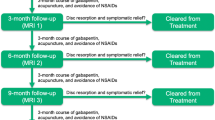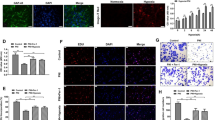Abstract
Objective
Intervertebral disc degeneration (IDD) is a key element resulting in low back pain, but the mechanisms underlying IDD remain largely unknown. The purpose of the study was to investigate the influence of microRNA-155-3p (miR-155-3p) on proliferation and autophagy of nucleus pulposus (NP) cells in IDD with the involvement of hypoxia-inducible factor 1 α (HIF1α)/histone lysine demethylase 3A (KDM3A) axis.
Methods
IDD NP tissues of patients with lumbar disc herniation and traumatic intervertebral disc NP tissues from patients with traumatic lumbar fracture were collected. Apoptosis in NP tissues was observed, and autophagy marker proteins in NP tissues were detected. NP cells in IDD were transfected with miR-155-3p mimic or KDM3A-siRNA to explore their roles in cell proliferation, autophagy and apoptosis. MiR-155-3p, KDM3A and HIF1α expression in NP tissues and cells were detected.
Results
Decreased miR-155-3p, and elevated HIF1α and KDM3A were presented in NP tissues and cells of IDD. Elevated miR-155-3p or silenced KDM3A promoted the proliferation and autophagy, and inhibited the apoptosis of NP cells of IDD. Moreover, elevated miR-155-3p decreased KDM3A and HIF1α expression, while silenced KDM3A decreased HIF1α expression in NP cells with IDD.
Conclusion
The study concludes that up-regulated miR-155-3p or silenced KDM3A promotes the proliferation, autophagy, and restrains the apoptosis of NP cells of IDD via inhibition of HIF1α, which may be a promising approach for the treatment of IDD.






Similar content being viewed by others
References
Ruiz-Fernandez C, et al. Molecular relationships among obesity, inflammation and intervertebral disc degeneration: are adipokines the common link? Int J Mol Sci. 2019;20(8):2030.
Zhang Y, et al. Overexpression of miR-150 inhibits the NF-kappaB signal pathway in intervertebral disc degeneration through targeting P2X7. Cells Tissues Organs. 2019;207(3–4):165–76.
Wang M, et al. Multiparametric MR investigation of proteoglycan diffusivity, T2 relaxation, and concentration in an ex vivo model of intervertebral disc degeneration. J Magn Reson Imaging. 2019;51:1390.
Zhang B, et al. Moxibustion alleviates intervertebral disc degeneration via activation of the HIF-1alpha/VEGF pathway in a rat model. Am J Transl Res. 2019;11(9):6221–31.
Wu D, et al. The effects of simulated +Gz and microgravity on intervertebral disc degeneration in rabbits. Sci Rep. 2019;9(1):16608.
Zhang G, et al. MicroRNA-155-3p promotes breast cancer progression through down-regulating CADM1. Onco Targets Ther. 2019;12:7993–8002.
Wu T, et al. miR-155 modulates TNF-alpha-inhibited osteogenic differentiation by targeting SOCS1 expression. Bone. 2012;51(3):498–505.
Wang X, et al. MicroRNA-155-3p mediates TNF-alpha-inhibited cementoblast differentiation. J Dent Res. 2017;96(12):1430–7.
Wang HQ, et al. Deregulated miR-155 promotes Fas-mediated apoptosis in human intervertebral disc degeneration by targeting FADD and caspase-3. J Pathol. 2011;225(2):232–42.
Zhang WL, et al. Role of miR-155 in the regulation of MMP-16 expression in intervertebral disc degeneration. J Orthop Res. 2017;35(6):1323–34.
Liu X, et al. KDM3A inhibition modulates macrophage polarization to aggravate post-MI injuries and accelerates adverse ventricular remodeling via an IRF4 signaling pathway. Cell Signal. 2019;64:109415.
Nakatsuka T, et al. Impact of histone demethylase KDM3A-dependent AP-1 transactivity on hepatotumorigenesis induced by PI3K activation. Oncogene. 2017;36(45):6262–71.
Ramadoss S, Guo G, Wang CY. Lysine demethylase KDM3A regulates breast cancer cell invasion and apoptosis by targeting histone and the non-histone protein p53. Oncogene. 2017;36(1):47–59.
Ramadoss S, et al. Lysine-specific demethylase KDM3A regulates ovarian cancer stemness and chemoresistance. Oncogene. 2017;36(11):1537–45.
Ikeda S, et al. Hypoxia-inducible KDM3A addiction in multiple myeloma. Blood Adv. 2018;2(4):323–34.
Mimura I, et al. Dynamic change of chromatin conformation in response to hypoxia enhances the expression of GLUT3 (SLC2A3) by cooperative interaction of hypoxia-inducible factor 1 and KDM3A. Mol Cell Biol. 2012;32(15):3018–32.
Li Y, et al. HIF- and non-HIF-regulated hypoxic responses require the estrogen-related receptor in Drosophila melanogaster. PLoS Genet. 2013;9(1):e1003230.
Yu H, et al. Expression of HIF1alpha in cycling stretchinduced osteogenic differentiation of bone mesenchymal stem cells. Mol Med Rep. 2019;20(5):4489–98.
Yang D, et al. Role of Mir-155 in controlling HIF-1alpha level and promoting endothelial cell maturation. Sci Rep. 2016;6:35316.
Tuo YL, Li XM, Luo J. Long noncoding RNA UCA1 modulates breast cancer cell growth and apoptosis through decreasing tumor suppressive miR-143. Eur Rev Med Pharmacol Sci. 2015;19(18):3403–11.
Gao ZX, et al. LncRNA SNHG6 can regulate the proliferation and apoptosis of rat degenerate nucleus pulposus cells via regulating the expression of miR-101-3p. Eur Rev Med Pharmacol Sci. 2020;24(16):8251–62.
Ding H, Xu Y, Jiang N. Upregulation of miR-101a suppresses chronic renal fibrosis by regulating KDM3A via blockade of the YAP-TGF-beta-smad signaling pathway. Mol Ther Nucleic Acids. 2020;19:1276–89.
Liu J, et al. Long noncoding RNA MIAT knockdown potentiates the therapeutic effect of transcatheter arterial embolization in liver cancer by regulating the miR203a/HIF1alpha axis. Oncol Rep. 2020;44(2):722–34.
Zhou J, et al. MicroRNA-155 suppresses the catabolic effect induced by TNF-alpha and IL-1beta by targeting C/EBPbeta in rat nucleus pulposus cells. Connect Tissue Res. 2019;60(2):165–77.
Divi SN, et al. Circulating miR-155–5p as a novel biomarker of lumbar degenerative disc disease. Spine (Phila Pa 1976). 2020;45(9):E499–507.
Sun J, et al. Transcription factor 7-like 2 controls matrix degradation through nuclear factor kappaB signaling and is repressed by microRNA-155 in nucleus pulposus cells. Biomed Pharmacother. 2018;108:646–55.
Wang Y, et al. NT21MP negatively regulates paclitaxel-resistant cells by targeting miR1553p and miR155-5p via the CXCR4 pathway in breast cancer. Int J Oncol. 2018;53(3):1043–54.
Xiao T, et al. NF-kappaB-regulation of miR-155, via SOCS1/STAT3, is involved in the PM2.5-accelerated cell cycle and proliferation of human bronchial epithelial cells. Toxicol Appl Pharmacol. 2019;377:114616.
Wang F, et al. MiR-155-5p inhibits PDK1 and promotes autophagy via the mTOR pathway in cervical cancer. Int J Biochem Cell Biol. 2018;99:91–9.
Du ZM, et al. Upregulation of MiR-155 in nasopharyngeal carcinoma is partly driven by LMP1 and LMP2A and downregulates a negative prognostic marker JMJD1A. PLoS ONE. 2011;6(4):e19137.
Wan W, et al. Histone demethylase JMJD1A promotes urinary bladder cancer progression by enhancing glycolysis through coactivation of hypoxia inducible factor 1alpha. Oncogene. 2017;36(27):3868–77.
Thorpe AA, et al. Thermally triggered injectable hydrogel, which induces mesenchymal stem cell differentiation to nucleus pulposus cells: potential for regeneration of the intervertebral disc. Acta Biomater. 2016;36:99–111.
Acknowledgements
We would like to acknowledge the reviewers for their helpful comments on this paper.
Funding
This work was supported by A research on personalized spinal three-dimensional printing intervertebral fusion cage in crenel lateral interbody fusion, office-level projects, 2019ZY1031, Key Scientific Research Projects on Chinese Medicine in Henan Province; Clinical application of personalized three-dimensional printing on external fixation of distal radius fractures, office-level projects, 1723001A-4, Scientific and Technological Development Projects in Luoyang City.
Author information
Authors and Affiliations
Corresponding author
Ethics declarations
Conflict of interest
The authors declare that they have no conflicts of interest.
Additional information
Responsible Editor: John Di Battista.
Publisher's Note
Springer Nature remains neutral with regard to jurisdictional claims in published maps and institutional affiliations.
Rights and permissions
About this article
Cite this article
Zhou, X., Li, J., Teng, J. et al. microRNA-155-3p attenuates intervertebral disc degeneration via inhibition of KDM3A and HIF1α. Inflamm. Res. 70, 297–308 (2021). https://doi.org/10.1007/s00011-021-01434-5
Received:
Revised:
Accepted:
Published:
Issue Date:
DOI: https://doi.org/10.1007/s00011-021-01434-5




